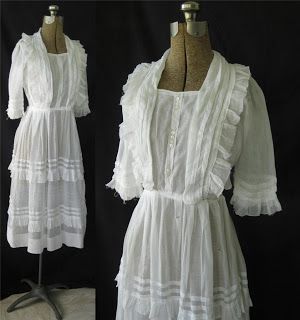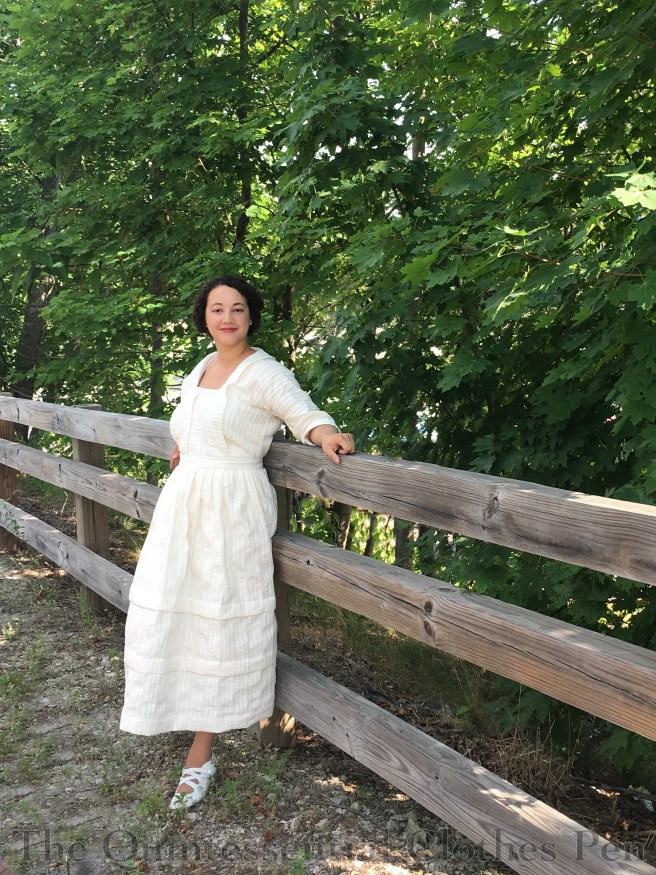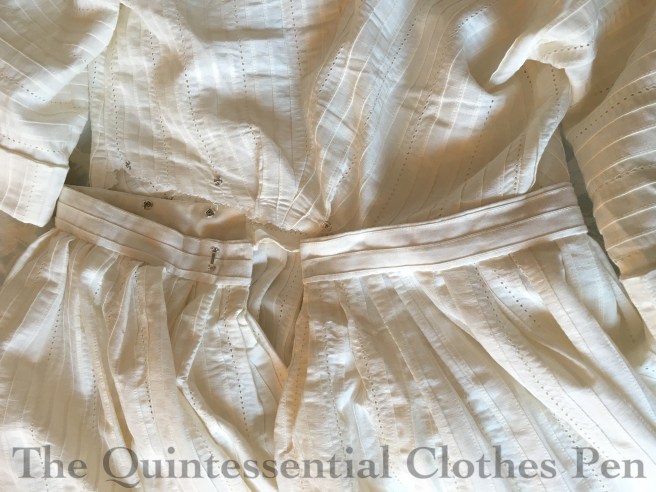I have a three evening gowns from the 1920s, but only two daytime ensembles. For summer events from the Ragtime dance period and the 1920s in general, I wanted a new addition in the daywear lineup, so I kept my eyes open while out shopping for other projects. I came across the fabric for this dress a few months ago before I had time to sew, but with a general plan in mind.
Fast forward to about a month ago and I started actually planning the dress. I had thought to make a dress from about 1916 with a distinct a-line shape (a silhouette like this), but reconsidered that plan when considering the very linear effect of the tucks in the fabric. The linear fabric was much more suited to the period from 1919 to 1922 and so down that road I went.
Just the facts:
Fabric: 4.5 yards pre-tucked ivory cotton.
Pattern: Adapted from Past Patterns #9127, Ladies’ Dress 1918-1920.
Year: 1919, explained in detail further along in the post.
Notions: Thread, snaps, and a hook and bar.
How historically accurate is it?: 95%. Accurate pattern from the period, reasonable fabric, and accurate finishing methods. Woo!
Hours to complete: 30? I took my time to enjoy the process, hand sewed more than was absolutely necessary in order to watch Netflix and not dig out the sewing machine, and fiddled with the bodice for awhile to get a style I was satisfied with.
First worn: July 17 for a Ragtime tea dance.
Total cost: $30 for the fabric.
(Edit: I forgot to mention what HSF challenge this was for when I originally published the post. It’s for challenge #7: Monochrome.)
Why did I decide on 1919 for the year of my dress? The pattern dates to 1918-1920, putting my dress squarely in the middle, but I also looked at the details that changed with each year from 1918-1922 to confirm the plan.





1919 is the year when the features I most wanted all come together: full skirt, high waist, playing with the linear nature of my fabric going both vertically and horizontally, and skirt tucks. These features can be seen in the following most inspirational images.




Plus, these two fashion plates, from 1920 and 1921.
And construction? I kept it simple, with a few unfinished edges in the skirt (gasp!), pinking on the seams and exposed edges in the bodice, and as few closures as possible. No fuss. The bodice closes off center in front but the skirt closes in back because I was originally planning to make a separate blouse and skirt. When I decided I didn’t feel like dealing with a peplum, and that even with a peplum a blouse was likely to come untucked (as happens with my 1917 blouse when I wear it), I just hand sewed the now-bodice to the inside of the waistband and sewed snaps around the other side to keep it together, as you can see. This way, it’s easy to separate the two pieces in the future.
All in all, a pretty quick project as my projects go. Comfortable, flattering, easy to alter (a component of sewing projects I am trying to incorporate more often as I move forward with projects), satisfying to wear, plus it goes well with my Astoria shoes. Win!






Love this style!! This may be the new time period I jump into. I just love the simplicity of the lines and the skirt still has just a little bit of flow, but it’s chic. 🙂 Well done.
Thanks! It’s a time period that is less often done, but it is actually on the simple side and flattering, too! 🙂
Beautiful. Light. Summer-like simplicity.
I have a soft spot for day dresses and this one is no exeption. Thank you for sharing the details.
Thanks, Sabine! 🙂
Hello, I happened across your blog because I am looking to make a dress from 1919 to wear when I volunteer at the Barberville Pioneer Art Settlement near Daytona Beach, FL. That is the time period they represent. I am hesitant to order that pattern until I know more about the fit and size. Would you mind to email me and answer a few questions I don’t want to ask here in your blog comments?
Ok, now this dress is totally fun! I love it and the era you chose to make it in. The fabric is totally sweet as well! You look super awesome in the late teens era!!!
Blessings!
g
Thanks, Gina! I am pleased that the fabric works so well for the dress! That’s half the battle, picking the right fabrics.
Very cute! This looks like a perfectly breezy dress for summer dancing 🙂
Indeed! It was quite comfortable. And bonus, it was comfortable in the car, too! It will be making an appearance again in late August. 🙂